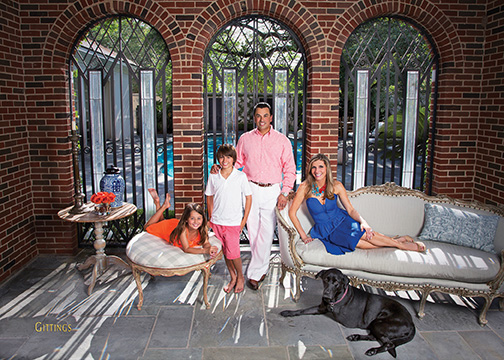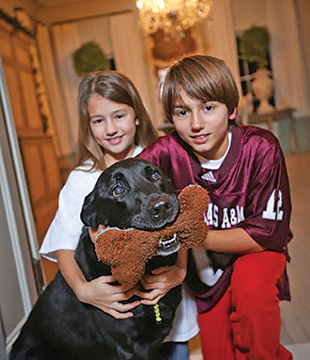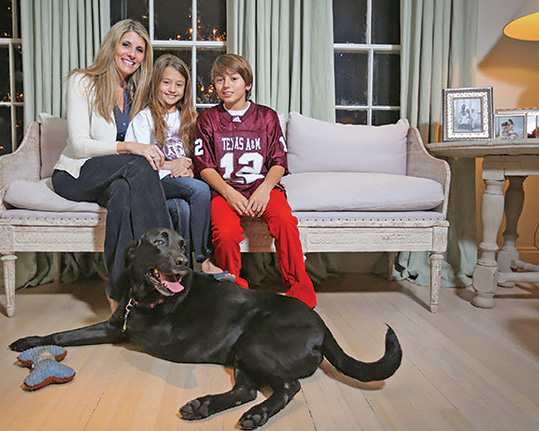Love to the Max: Texas A&M veterinarians help a family through the pain of canine cancer

Upon entering the Bhatia home in Houston, it’s apparent that the family dog, Maxamillion, is as much a thread in the fabric of the household as his human counterparts.
With an energetic tail and a doggy smile, Max is the first to greet any guest. In nearly every framed photo in the home, he poses for the camera. And, as his mom Gina Bhatia will tell you, it is required that Max go on almost all family vacations within driving distance. For the past eight years, Max has been part of the family, beginning on the day Gina Bhatia and her husband, Devinder, bid on the black Labrador puppy at a school charity auction.
“My husband kept on bidding until he was ours. I was dressed in a ball gown, and they handed over this precious pooch,” she laughed. “We had a new baby, a toddler, a freshman in high school, and our house was under renovations. I looked at my husband like, ‘What did we just do?'”
The Bhatias didn’t question their decision long. Max took hold of their hearts almost instantly.
 When Max was five years old, his health took a sudden turn. During a family vacation, one that Max didn’t go on, Bhatia received a call from the boarder. “They said that Max was not himself at all, that he had started limping and was acting lethargic,” Bhatia explained. So she ended the trip early and headed home in order to take Max to his local veterinarian, Dr. Alice Anne Dodge, in Houston. While there, she found out that Max was suffering from an autoimmune disease and polyarthritis. After weeks of tests and different medications, he was not getting any better. At that point, his veterinarian recommended that he be taken to the Veterinary Medical Teaching Hospital at Texas A&M University.
When Max was five years old, his health took a sudden turn. During a family vacation, one that Max didn’t go on, Bhatia received a call from the boarder. “They said that Max was not himself at all, that he had started limping and was acting lethargic,” Bhatia explained. So she ended the trip early and headed home in order to take Max to his local veterinarian, Dr. Alice Anne Dodge, in Houston. While there, she found out that Max was suffering from an autoimmune disease and polyarthritis. After weeks of tests and different medications, he was not getting any better. At that point, his veterinarian recommended that he be taken to the Veterinary Medical Teaching Hospital at Texas A&M University.
“He had tons of blood tests, scans, X-rays-you name it, they did it,” said Bhatia. “He wasn’t walking, and his platelet levels dropped dangerously low.”
The Texas A&M veterinarians figured out the plan of attack, giving Max a round of chemotherapy and a litany of other medications. Over the next six months, many visits to Texas A&M, and seven different medicines, Max’s condition improved tremendously. The Bhatias were overjoyed.
A dreaded diagnosis
For years, Max showed no sign of his previous illness. Although his energy never returned to its original puppy-like volume, Max was back to being Max.
Then, last April, Bhatia noticed Max limping. She returned to Dr. Dodge, where she left him to undergo a series of tests. For the entire day, Bhatia waited by the phone, nervous about the news she would receive. When she finally got the call at the end of the day to come pick up Max, she knew the news wasn’t good. “When I went in, I was sitting in the exam room with Max, and the doctor came in and said, ‘I hope I’m wrong, but I think he has osteosarcoma.'”
With the overwhelming news of cancer, Bhatia left Dodge’s office heartbroken, afraid her days with her beloved pet were numbered.
After consulting with her husband, a heart surgeon, Bhatia knew that the best course of action would once again involve Texas A&M. She drove Max back to College Station two days later, where Dr. Claudia Barton and the rest of the oncology team did more testing and a biopsy to confirm an aggressive form of cancer called osteosarcoma. Dr. Rita Ho, Dr. Megan Sutton, Dr. Kelly Theiman Mankin, and Dr. Heather Wilson-Robles, together with Barton, gave her several treatment options. One option was to amputate Max’s front left leg and administer six rounds of chemotherapy, and another treatment option would allow him to keep his leg and undergo radiation. The former option meant drastic changes for Max’s future but a longer life, while the latter option was less invasive but wouldn’t completely eliminate his pain.
“It took me a good week to figure out what to do,” Bhatia said. “I couldn’t eat. I couldn’t sleep. In my mind, the thought of amputation was such an aggressive approach. The thing that kept me going was that they do this surgery a lot, that it’s fairly common with big dogs. Plus, the veterinarians assured me that Max has such a great spirit, they knew that he would do fantastic. Once I discussed it again with my husband and children, we knew he was going to be a survivor.”
 With encouragement from the veterinarians at Texas A&M, Bhatia made peace with her decision to move forward with the amputation. They were careful to explain every scenario to Bhatia-“the good, the bad, and the ugly.” She felt that all of the veterinarians and students formed a bond with Max that assured her he was in good hands.
With encouragement from the veterinarians at Texas A&M, Bhatia made peace with her decision to move forward with the amputation. They were careful to explain every scenario to Bhatia-“the good, the bad, and the ugly.” She felt that all of the veterinarians and students formed a bond with Max that assured her he was in good hands.
“Before I got him home, on the night of his surgery, they called me, and I was just blown away. They told me he was doing great and that he was already walking!”
Within two weeks, Max had completely adapted to his new body. Bhatia’s children, Mia and Drake, were able to play with their dog in the backyard, just like old times.
“Max is just the best gift from God. He gives us so much,” Bhatia said. “If you have a sick pet and are considering the veterinarian school at Texas A&M, don’t think twice about it. Get in your car and go right now. They are the best, and I’m forever grateful.”
Editor’s note: As this issue was going to print, Max lost his battle with cancer. However, the Bhatia family is still very grateful for the extra time they were able to spend with their beloved dog.


